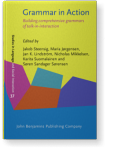Chapter 10
Copula variation in Danish and the intertwined nature of
grammar
This chapter explores constructions with the copula verb
er ‘is’ in Danish. Practices employing zero
copula assessments, stressed copulas and cases where syntax requires
overt copula are described. Data are informal Danish
interactions.
The constructions are analyzed using Conversation
Analysis and Interactional Linguistics. It is found that in reduced
or zero copula clauses, the features of the action may depend on the
predicate phrase rather than the copula. Stressed
er marks a turn as asserting or contrasting
with something that came before. The syntactic context requiring
overt copula may project turn-ending.
The aim is to discuss how the constructions studied are
intertwined with other aspects of grammar and how they may fit into
an interactional grammar like the Danish project
Samtalegrammatik.dk.
Article outline
- 1.Introduction
- 2.Background
- 2.1Copula and its variation
- 2.2Copula in Danish grammar
- 2.3Copula in Danish phonetics and phonology
- 2.4Copula in assessments
- 3.Methods and data
- 4.Analysis
- 4.1Copula assessments
- 4.2Stressed er
- 4.3Syntactically conditioned overt copula
- 5.Discussion
- 5.1Copula in interaction
- 5.2Copula in the grammar of clause types
- 5.3Copula in the grammar of stress
- 5.4Copula in phonology
- 5.5Copula in Samtalegrammatik.dk
- 6.Conclusion
-
Acknowledgments
-
Notes
-
References
This content is being prepared for publication; it may be subject to changes.
